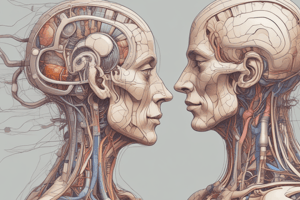Podcast
Questions and Answers
What are the 3 categories of muscles?
What are the 3 categories of muscles?
- Smooth Muscles (correct)
- Skeletal/Striated Muscles (correct)
- Cardiac Muscles (correct)
- All of the above
What is it called when skeletal muscles can be fast or slow?
What is it called when skeletal muscles can be fast or slow?
Fast-twitch or Slow-twitch
The Golgi Tendon Organ is located in the muscles.
The Golgi Tendon Organ is located in the muscles.
False (B)
What are reflexes?
What are reflexes?
What is a monosynaptic Reflex?
What is a monosynaptic Reflex?
What is a central pattern generator?
What is a central pattern generator?
What is the role of the prefrontal cortex?
What is the role of the prefrontal cortex?
What is a brain-computer interface (BCI)?
What is a brain-computer interface (BCI)?
What is the role of the cerebral cortex?
What is the role of the cerebral cortex?
What does the medial tract control?
What does the medial tract control?
What is the role of the brainstem in movement?
What is the role of the brainstem in movement?
What is the cerebellum associated with and how many neurons are there?
What is the cerebellum associated with and how many neurons are there?
What does damage to the cerebellum cause?
What does damage to the cerebellum cause?
What is the basal ganglia?
What is the basal ganglia?
What is the basal ganglia responsible for?
What is the basal ganglia responsible for?
What is the basal ganglia comprised of?
What is the basal ganglia comprised of?
What are the pathways for Input and Output of the Basal Ganglia?
What are the pathways for Input and Output of the Basal Ganglia?
How does a basal ganglia select a movement?
How does a basal ganglia select a movement?
What happens when new skills are learned?
What happens when new skills are learned?
What happens with conscious decisions and movement?
What happens with conscious decisions and movement?
What is a readiness potential?
What is a readiness potential?
What are movement disorders?
What are movement disorders?
What are the movement symptoms of Parkinson's Disease? (Select all that apply)
What are the movement symptoms of Parkinson's Disease? (Select all that apply)
What are the symptoms of parkinsons?
What are the symptoms of parkinsons?
What causes Parkinsons?
What causes Parkinsons?
What does the substantia nigra do?
What does the substantia nigra do?
How does loss of dopamine affect the motor cortex?
How does loss of dopamine affect the motor cortex?
What is the treatment for Parkinson's?
What is the treatment for Parkinson's?
What are other treatments for Parkinsons?
What are other treatments for Parkinsons?
What is Huntington's Disease?
What is Huntington's Disease?
What are the physical symptoms of Huntington's disease? (Select all that apply)
What are the physical symptoms of Huntington's disease? (Select all that apply)
What are the cognitive symptoms of Huntington's disease? (Select all that apply)
What are the cognitive symptoms of Huntington's disease? (Select all that apply)
What are the emotional symptoms of Huntington's disease? (Select all that apply)
What are the emotional symptoms of Huntington's disease? (Select all that apply)
What are presymptomatic tests?
What are presymptomatic tests?
What controls hereditary diseases?
What controls hereditary diseases?
What is the likelihood of getting a disease?
What is the likelihood of getting a disease?
Flashcards
Smooth Muscles
Smooth Muscles
Muscles that control the movement of organs like the digestive tract.
Skeletal/Striated Muscles
Skeletal/Striated Muscles
Muscles that control body movement.
Cardiac Muscles
Cardiac Muscles
The muscles of the heart.
Neuromuscular Junction
Neuromuscular Junction
Signup and view all the flashcards
Acetylcholine
Acetylcholine
Signup and view all the flashcards
Antagonistic Muscles
Antagonistic Muscles
Signup and view all the flashcards
Flexor Muscle
Flexor Muscle
Signup and view all the flashcards
Extensor Muscle
Extensor Muscle
Signup and view all the flashcards
Fast-twitch Muscles
Fast-twitch Muscles
Signup and view all the flashcards
Slow-twitch Muscles
Slow-twitch Muscles
Signup and view all the flashcards
Proprioceptors
Proprioceptors
Signup and view all the flashcards
Muscle Spindles
Muscle Spindles
Signup and view all the flashcards
Golgi Tendon Organ
Golgi Tendon Organ
Signup and view all the flashcards
Reflexes
Reflexes
Signup and view all the flashcards
Monosynaptic Reflex
Monosynaptic Reflex
Signup and view all the flashcards
Central Pattern Generator
Central Pattern Generator
Signup and view all the flashcards
Motor Program
Motor Program
Signup and view all the flashcards
Brain-Computer Interface (BCI)
Brain-Computer Interface (BCI)
Signup and view all the flashcards
Cerebral Cortex
Cerebral Cortex
Signup and view all the flashcards
Prefrontal Cortex
Prefrontal Cortex
Signup and view all the flashcards
Premotor Cortex
Premotor Cortex
Signup and view all the flashcards
Primary Motor Cortex
Primary Motor Cortex
Signup and view all the flashcards
Posterior Parietal Cortex
Posterior Parietal Cortex
Signup and view all the flashcards
Antisaccade Task
Antisaccade Task
Signup and view all the flashcards
Mirror Neurons
Mirror Neurons
Signup and view all the flashcards
Corticospinal Tracts
Corticospinal Tracts
Signup and view all the flashcards
Lateral Corticospinal Tract
Lateral Corticospinal Tract
Signup and view all the flashcards
Medial Corticospinal Tract
Medial Corticospinal Tract
Signup and view all the flashcards
Basal Ganglia
Basal Ganglia
Signup and view all the flashcards
Tourette's syndrome
Tourette's syndrome
Signup and view all the flashcards
Study Notes
Movement
- Three categories of muscles: Smooth, Skeletal/Striated, and Cardiac.
- Smooth muscles control digestive and internal organs.
- Skeletal muscles control voluntary movements.
- Cardiac muscles control the heart.
- Muscle fibers receive information from a motor neuron axon.
- A neuromuscular junction is a synapse between a motor neuron axon and a muscle fiber.
- Acetylcholine causes muscle contraction.
- Antagonistic muscles work in pairs to produce movement.
- Flexors bend a joint; Extensors straighten a joint.
- Fast-twitch muscle fibers contract quickly but fatigue rapidly.
- Slow-twitch muscle fibers contract more slowly but do not fatigue easily.
- Proprioceptors are receptors that detect the position and movement of body parts.
- Muscle spindles and Golgi tendon organs are types of proprioceptors.
Reflexes and Movement Control
- Reflexes are involuntary, consistent, and automatic responses to stimuli.
- Monosynaptic reflexes involve one synapse.
- Movements can be reflexive or voluntary.
- A central pattern generator generates rhythmic movement patterns.
- A motor program is a learned or built-in sequence of movements.
- A brain-computer interface uses brain signals to control devices.
- Major components of motor system include the Cerebrum (forebrain), brainstem, and spinal cord.
- The cerebral cortex plans and executes complex behaviors.
- The prefrontal cortex plans movements.
- The premotor cortex produces movement sequences.
- The primary motor cortex controls specific areas of the body.
The Brain and Movement
- The primary motor cortex is involved in movement.
- The somatosensory cortex plays a role in the primary motor cortex.
- The posterior parietal cortex plans movements.
- Anti-saccade tasks inhibit movements.
- Mirror neurons may be involved in imitation and understanding of actions.
Spinal Cord and Tracts
- The corticospinal tracts are pathways between the brain and spinal cord.
- The lateral corticospinal tract controls peripheral areas like hands and feet..
- The medial corticospinal tract controls trunk and neck muscles.
- The red nucleus and vestibular nucleus are involved in motor control.
Brain Stem and Movement
- The brainstem helps maintain posture and coordinates bilateral body movements.
- The brainstem is involved in movement, posture, and balance.
Disorders
- Locked-in syndrome: a condition of complete paralysis except for eye movements.
- Spinal cord damage can result in quadriplegia or paraplegia, causing paralysis and loss of sensation.
- Spinal reflexes are still possible after spinal cord injury.
- Various disorders such as Paralysis, Quadriplegia, Hemiplegia, Tabes Dorsalis, Poliomyelitis or Amyotrophic lateral sclerosis affect movement.
Huntington's Disease
- Huntington's disease is a neurological disorder characterized by motor symptoms, cognitive decline, and emotional disturbances.
- It affects approximately 1 in 7000 individuals in Canada and typically emerges between ages 30 to 50.
- Symptoms involve involuntary movements (chorea), cognitive problems, and emotional changes.
- Presymptomatic testing and genetic screening can identify those at risk of acquiring Huntington's.
- The disease is hereditary and is linked to a specific genetic mutation.
- It is progressive and ultimately fatal.
The Cerebellum
- The cerebellum plays a crucial role in balance, coordination, and precise control of movement.
- Damage to the cerebellum results in problems with rapid movements, timing, and coordination.
- The cerebellum receives information about intended movements and actual movements to calculate errors and correct movement sequences.
- The finger-to-nose test can be used to assess cerebellar function.
Basal Ganglia
- The basal ganglia are a group of subcortical structures involved in initiating and coordinating movement.
- Damage to the basal ganglia can cause involuntary movements or difficulties with initiating voluntary movements.
- Basal ganglia are responsible for selecting and initiating voluntary movements and inhibiting unwanted movements.
Parkinson's Disease
- Parkinson's is a movement disorder characterized by difficulties initiating, controlling, and coordinating movement.
- It's caused by neuronal death in the substantia nigra, which normally produces dopamine.
- Dopamine is critical for smooth, uncontrolled movements,
- Parkinsons symptoms include tremors, rigidity, slowness of movement, balance and posture problems.
- Treatments include medication such as L-dopa and other therapies.
Studying That Suits You
Use AI to generate personalized quizzes and flashcards to suit your learning preferences.





